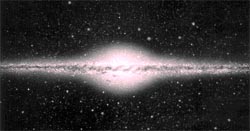Theory banged
 THE age of the universe as measured by some recent experiments seems to be less than that of some of the objects in it. The measured age of globular clusters in our galaxy is about 13 to 18 billion years, while the age of the universe Seems to be closer to 12 billion years. This observation goes against the Big Bang cosmological model, which explains a variety of observations like cosmic microwave background radiation and the synthesis of elements other than hydrogen.
THE age of the universe as measured by some recent experiments seems to be less than that of some of the objects in it. The measured age of globular clusters in our galaxy is about 13 to 18 billion years, while the age of the universe Seems to be closer to 12 billion years. This observation goes against the Big Bang cosmological model, which explains a variety of observations like cosmic microwave background radiation and the synthesis of elements other than hydrogen.
To make matters worse, there are reports of a fairly dependable measurement of the age of a single star in our halo between 13 and 21 billion years. J J Cowan and his group have reported measuring the age of cs22892-052, a remarkably ancient star in our own galactic halo. They have used the method of nucleocosmochronology to compare the value of the observed abundance of a long-lived radioactive isotope of Thorium 235, which has a half life of 14 billion years.
Most of the elements in the universe which are heavier than boron are formed in stars. When stars blow up, these elements are thrown back into the interstellar medium, where they are recycled into newer stars. This implies that the oldest stars in the galaxy ate metal poorer than our Sun.
Elements heavier than iron are not produced as a result of nuclear fusion but are assembled by addition of neutron to nuclei by a process called the r-process. Some of these heavier elements have long half lives and one can measure their abundances by looking for their spectral signatures in the form of absorption lines. Usually this is not very reliable because the absorption lines are masked by the line of iron, which is more abundant. In the case of chemically poor halo stars, the iron abundance is much less than in the Sun. On the other hand, the other elements are present in quantities sizeable enough to be measured because the processes leading to the incorporation of iron in halo stars is different.
The researchers have measured abundances of stable r-process elements in the star and compared them with the values in our own solar system. Most of the values match, but the value of Thorium 235 is almost half the solar value. The group then used a galactic evolution model, to find out L he age of cs22892-052.
Though the result is based on observations of one element and that too in one star, the warning signals to cosmologists is clear: that the Big Bang model is in deep trouble. Maybe the time has come to review the model.
